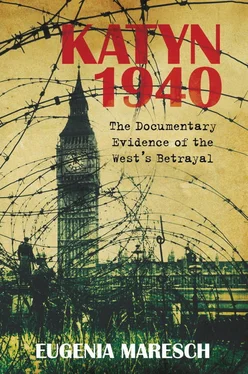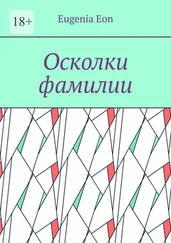During my stay at Katyn, Professor Buhtz lived at Smolensk and his trips to Katyn were irregular, one to three times a week. He usually appeared there when more important parties of visitors and delegations arrived at Katyn. In my opinion, Professor Buhtz approached the work as a man of science and because of his attitude he even had some disputes with the local chief of Propagandaamst section. Personally, I did not have close contact with Professor Buhtz and did not communicate with him about the material I collected.
The chief of German propaganda was an officer with a rank of Major. I do not remember his name. He lived at Smolensk and I saw him in Katyn at the most two or three times. His deputy OLt Slovenzik, who was a journalist by profession from Vienna, also lived at Smolensk and came to Katyn regularly, morning and afternoon. He devoted himself entirely to the exploitation of the Katyn woods as propaganda. Among other things, he expressed great indignation many times about the delegations of Polish officer PoWs from German camps, who, in spite of his great efforts, did not want to say anything during their stay in Katyn, declaring that, as prisoners, they had only duties and no rights.
OLt Slovenzik was also a local representative of the German authorities, with whom I had to be in touch rather often. There were disputes between us more than once, particularly on account of the fact that as the graves were being emptied in the course of our work, the number of exhumed corpses was still very far from the 12,000 as given out by the German propaganda. Leutnant Voss of the Geheimfeldpolizei represented the German Military authorities, besides OLt Sloventzyk. He was a typical German policeman, scrupulously executing orders, without reservation. It was his duty to find witnesses among the local population who would give information about the circumstances under which the Polish officers were brought to Katyn for liquidation. With regard to these witnesses, such as Kiselev and the man who worked in the station yard at Gnezdovo whose name I do not remember, I was not aware that the Germans subjected them to any compulsion or threats. Leutnant Voss’ duties also included guarding the Katyn woods and supervising the work carried our there. He had at his disposal five or six NCOs of Geheimfeldpolizei who came regularly to Katyn. When any of them did not supervise the work undertaken by the Technical Committee, he was immediately summoned to Voss and threatened with punishment. Voss also made sure that no photographs were taken at the scene of the crime and ordered temporary confiscation of cameras or removal of films. This order, however, did not apply to our Technical Committee members or to the German experts. I personally took many pictures of the scene but despite Slovenzik’s insistence I did not develop the films on the spot but took them back to Warsaw undeveloped and handed them over to the PCK Executive Committee.
Leutnant Voss also supervised the work connected with the documents found on the bodies and their removal to the laboratory for deciphering and conservation. He also had Russian civilian workers at his disposal who worked on the exhumations and Soviet prisoners who, at his or OLt Slovenzik’s request, were sent to Katyn from Smolensk. More than once, Leutnant Voss gave orders to the Russian workers on his own account, without consulting with the Technical Commission, thus interfering with the organisation of the exhumation.
During my stay at Katyn, I was never at the NKVD’s bungalow, which was situated about 800 to 1,000 metres from the scene of the crime, on the bank of the Dnieper River. However, I saw the bungalow, which was a one storey, roomy villa, situated about 15 metres from the bend of the river. Steps led to a small pier to which a small boat was moored. There were no German posts near the villa, but occasionally a Wehrmacht soldier would stroll around the grounds. There were a large number of telephone wires leading to the villa, which gave the impression it must have been some sort of headquarters. I was told that a Colonel stayed there. From time to time, I saw cars containing German officers driving in the direction of the villa. I did not recognise the colours of their uniforms, at any rate, they were neither officers of the GFP ( Geheimfeldpolitzei) nor the Gestapo. They did not show any interest in the work we were doing and I never saw the Colonel who was supposed to be living in the villa. I did however see Germans saluting the passing car.
Local People
In the vicinity of the Katyn crime, about half a kilometre away, were the houses of local people. Nearest to the woods was the hut inhabited by the Kiselev family. Old [Parfeon] Kiselev was brought to the scene more than once to be a witness. The next, larger settlement was the village of Borok mentioned earlier. On the edge of the village, there was an advance hospital unit of the Organisation Todt , to which, as I mentioned above, the Technical Committee was attached for the purpose of room and board.
German orders not to trespass in the Katyn woods were strictly obeyed by the local Russian population. It should be stressed that during our time at Katyn the Germans were masters of the main lines of communication; the partisans held the woods and more distant localities. Their presence undoubtedly acted as a brake on gossip by the locals. As I myself do not speak Russian I had no conversation with the local people. Messrs Wodzinowski and Jaworowski could speak good Russian and talked to them on different occasions. This is how we learned from them that they did not know of any camps with PoWs, or of Poles particularly, when the Soviets were in Katyn. They had hoped that the Germans would free them from the Bolshevik tyranny, but the Germans were treating them no better, indeed worse, than the Soviet authorities. It was difficult to get more information about the crime out of the locals, because they feared the partisans and the reprisal of the Soviet authorities.
The Principal Work Undertaken at Katyn Woods
1. Lifting out the corpses from the original graves
2. Examining them and determining the cause of death
3. Searching bodies for documentation and labelling them with new numbers
4. Identifying the bodies by items found on them
5. Reburial of the corpses in new communal graves.
1. Lifting out Bodies from the Original Graves
The local Russian civilians, about ten, dug the graves and uncovered the bodies under the supervision of individual members of the PCK Technical Commission overseen by Mr [Hugon] Kassur. The Russians worked in teams of two, so three groups worked on the graves, the others were tasked with carrying away the examined bodies. For the work of lifting the bodies, they used iron hooks to detach individual bodies from the mass. In spite of repeated warnings from Technical members, the bodies and especially the uniforms were often damaged in the course of this work. Besides the hooks, shovels were used for lifting, sometimes picks, because the bodies were firmly stuck together. I was obliged to agree to the use of such methods, but always recommended the use of hands where possible to avoid the possibility of artificial mutilation (artefacts). The fact that the bodies were so firmly compressed together precluded any suspicion of the bodies exhumed by the Technical Commission having been previously disturbed. The equal degree of putrefaction in the individual graves depended on the quality of the layer of soil and on the pressure put on each layer of bodies, which proved that all bodies had lain in various graves for the same period of time, which also meant that after the original closing of the graves, they had not subsequently been opened with a view to later burial of other bodies in the same graves.
Читать дальше












